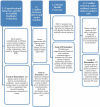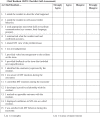Using Objective Structured Teaching Encounters (OSTEs) to prepare chief residents to be emotionally intelligent leaders
- PMID: 28460596
- PMCID: PMC5419302
- DOI: 10.1080/10872981.2017.1320186
Using Objective Structured Teaching Encounters (OSTEs) to prepare chief residents to be emotionally intelligent leaders
Abstract
Background: Chief Residents must lead, manage and mentor a diverse and often large group of residents, however there is a lack of formal leadership training throughout graduate medical education.
Objective: Development of a 3-part Chief Resident (CR) Program focused on leading, managing and mentoring.
Design: Each participant completes an Emotional Intelligence (EI) Inventory prior to the day-long event. Participants receive their EI scores at the beginning of the program, which features interactive sessions on leadership, management, and feedback skills. The program then reinforces the application of their new knowledge about EI through a four station OSTE (Observed Structured Teaching Encounter). CRs practice feedback and coaching skills in a simulated environment where they need to provide the context of formative feedback to a standardized resident.
Results: The aggregated mean pre-session EI score for all participants was 76.9 (an ideal score is >85). An independent-samples t-test compared the CRs' leadership and feedback performance on their first and second OSTE performance within a single afternoon session. There was a significant difference between the first OSTE performance (M = 47.92, SD = 7.8) and the second OSTE performance (M = 51.22, SD = 6.9); t (68) = 1.99, p = 0.006. These results suggest that participating in multiple OSTEs positively reinforces the core interpersonal and communication skills discussed in the didactic and practiced in the interactive portions of the program.
Conclusion: The low mean pre-session EI score achieved by our participants supports the idea that CRs enter their new roles with a level of EI that can be enhanced. CRs had an overall positive reaction to EI and its application to the core skills addressed in the program, highlighting the fact that similar programs could be used to train early career physicians to be more skilled and comfortable with leading, managing and mentoring.
Abbreviations: CR: Chief resident; EI: Emotional intelligence; GME: Graduate medical education; OSTE: Objective structured teaching encounter.
Keywords: Leadership training; OSTEs; chief residents; emotional intelligence; graduate medical education.
Figures
Similar articles
-
Difficult Interpersonal Encounters with Medical Students and Residents: Two Objective Standardized Teaching Encounters.MedEdPORTAL. 2017 Oct 11;13:10640. doi: 10.15766/mep_2374-8265.10640. MedEdPORTAL. 2017. PMID: 30800841 Free PMC article.
-
Effectiveness of a Leadership Development Course for Chief Residents: A Longitudinal Evaluation.J Grad Med Educ. 2020 Apr;12(2):193-202. doi: 10.4300/JGME-D-19-00542.1. J Grad Med Educ. 2020. PMID: 32322353 Free PMC article.
-
Objective Assessment of Resident Teaching Competency Through a Longitudinal, Clinically Integrated, Resident-as-Teacher Curriculum.Acad Pediatr. 2019 Aug;19(6):698-702. doi: 10.1016/j.acap.2019.01.011. Epub 2019 Mar 8. Acad Pediatr. 2019. PMID: 30853578
-
The Objective Structured Teaching Encounter (OSTE) in health professions education: A systematic review.Med Teach. 2023 Aug;45(8):893-905. doi: 10.1080/0142159X.2023.2189539. Epub 2023 Mar 20. Med Teach. 2023. PMID: 36940135
-
Objective Assessment of General Surgery Residents Followed by Remediation.J Surg Educ. 2016 Nov-Dec;73(6):e71-e76. doi: 10.1016/j.jsurg.2016.07.002. Epub 2016 Jul 29. J Surg Educ. 2016. PMID: 27476792 Review.
Cited by
-
A unique approach to faculty development using an Observed Structured Teaching Encounter (OSTE).Med Educ Online. 2018 Dec;23(1):1527627. doi: 10.1080/10872981.2018.1527627. Med Educ Online. 2018. PMID: 30345901 Free PMC article.
-
Is postgraduate leadership education a match for the wicked problems of health systems leadership? A critical systematic review.Perspect Med Educ. 2019 Jun;8(3):133-142. doi: 10.1007/s40037-019-0517-2. Perspect Med Educ. 2019. PMID: 31161480 Free PMC article.
-
Objective structured teaching examination (OSTE): an underused tool developed to assess clinical teaching skills. A narrative review of the literature.Sao Paulo Med J. 2019 Jun 10;137(2):193-200. doi: 10.1590/1516-3180.2018.0308161118. Sao Paulo Med J. 2019. PMID: 31314881 Free PMC article. Review.
-
Receiving Real-Time Clinical Feedback: A Workshop and OSTE Assessment for Medical Students.Adv Med Educ Pract. 2020 Nov 12;11:861-867. doi: 10.2147/AMEP.S271623. eCollection 2020. Adv Med Educ Pract. 2020. PMID: 33209072 Free PMC article.
-
Effectiveness of a SNAPPS in psychiatric residents assessed using objective structured teaching encounters: a case-control study.Sao Paulo Med J. 2022 Oct 3;141(3):e20211028. doi: 10.1590/1516-3180.2021.1028.R1.13072022. eCollection 2022. Sao Paulo Med J. 2022. PMID: 36197349 Free PMC article. Clinical Trial.
References
-
- Taylor C, Farver C, Stoller JK. Can emotional intelligence training serve as an alternative approach to teaching professionalism to residents? Acad Med. 2011;86:1551–7. - PubMed
-
- Grant I, Dorus W, McGlashan T. The chief resident in psychiatry. Arch Gen Psychiatry. 1974;30:503–507. - PubMed
-
- Blumenthal DA, Bernard K, Bohnen J. Addressing the leadership gap in medicine: residents’ need for systematic leadership development training. Acad Med. 2012;87:513–522. - PubMed
-
- Gewertz B, Logan D. The best medicine: a physician’s guide to effective leadership. New York, NY: Springer-Verlag; 2015.
-
- Goleman D. Emotional Intelligence. New York, NY: Random House; 2012.
MeSH terms
LinkOut - more resources
Full Text Sources
Other Literature Sources




